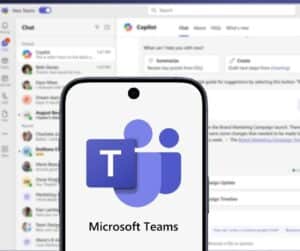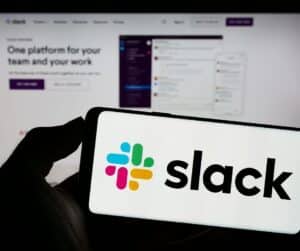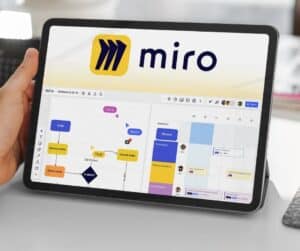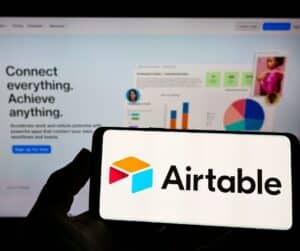Remote working, hybrid or multi-site teams are now part of everyday life in many organizations. How do you maintain effective collaboration in this context? Collaborative tools help to organize workflows, improve exchanges and centralize information. Whether you’re a start-up, a small business or a major corporation, you can rely on a solution tailored to your needs. The key is to choose a tool that meets your real needs.
To help you make the right choice, Qim info has selected the ten best collaborative tools of the moment, to compare according to your priorities:
- Coordination: ensure clear, ongoing communication between teams.
- Productivity: simplify task management and speed up processes.
- Accessibility: enabling everyone to collaborate wherever they are, on any medium.
- Compatibility: easily integrate existing tools into your work environment.
How do you choose the right collaborative tool for your team?
A high-performance tool poorly aligned with your needs can slow down group dynamics. Before making any comparisons, it’s best to consider the actual uses, the constraints of your environment and the expectations of your teams. The role of the project manager is essential in guiding these choices and guaranteeing adoption by the team. To find out more about the role of the project manager, read our article: Everything you need to know about the project manager’s job.
Here are the essential criteria to consider:
Ease of use
A tool that is easy to use makes it easier for all employees to adopt. Interface ergonomics play a decisive role, especially when technical and non-technical profiles work side by side. The more intuitive the tool, the greater the collective commitment.
Functional relevance
Instant messaging, project management, file sharing or task tracking: every team has its own priorities and challenges. To compare solutions effectively, it’s essential to draw up a clear list of day-to-day uses, and to identify real-life use cases (meetings, document validation, reporting, customer follow-up, etc.). This approach enables you to identify the tools that are really best suited to your needs, without getting bogged down in superfluous functionalities.
Compatibility with your digital environment
The effectiveness of a collaborative tool also depends on its ability to integrate with existing tools. To avoid disruptions in work processes, you need to choose a solution that is compatible with your ecosystem: Google Workspace, Microsoft 365, CRM, business software or communication platforms.
Cost and scalability
A good collaborative tool must be able to evolve with the company. Formulas must be adapted to team size, usage and available resources. You need to compare the number of users included, the functionalities available in each plan, and any restrictions. A clear, modular offer with no nasty surprises is a real plus in the long term.
Eliminating organizational irritants
Choosing the right tool also means resolving current dysfunctions: fragmented communications, scattered documents, difficulty in keeping track of priorities. The ideal solution really does simplify day-to-day operations, by adapting to existing processes and centralizing essential exchanges.
Notion
Notion is a collaborative platform designed to structure information and organize work within teams. It combines note-taking, databases, tasks and documentation in a customizable space, suitable for a wide range of professional uses.

Notion features
- Hierarchical, modular workspaces, adapted to each project or team
- Customizable content blocks: pages, tables, databases, lists, calendars, etc.
- Real-time collaboration with simultaneous editing and change history
- Ready-to-use templates for structuring documentation, onboarding, schedules or roadmaps
- Smooth navigation thanks to an integrated search engine and relational links between pages
Advantages and disadvantages of Notion
✅ Great flexibility for a wide range of uses
✅ Clean, easy-to-customize interface
✅ Many ready-to-use models
✅ Can be integrated via API or third-party connectors
❌ Limited reporting for advanced management
❌ Less suitable for complex, multi-team projects
❌ Longer learning curve for beginners
Notion prices
- Free: limited functionality
- Charge: from €11.50 / user / month
What Qim info thinks of Notion
Notion is very useful for teams looking for structured, adaptable documentation. Recommended for structures wishing to document their processes, centralize knowledge and encourage team autonomy.
Microsoft Teams
Microsoft Teams is a communication and collaboration platform, integrated into the Microsoft Office 365 suite. It centralizes exchanges, documents and teamwork, simplifying coordination, whether in real time or off-line.

Teams features
- Discussion channels by team or theme to structure exchanges
- Enhanced instant messaging: mentions, file sharing, emojis, GIFs
- Audio calls and video conferences with screen sharing, recording and subtitling
- Co-edit Word, Excel or PowerPoint documents directly in the interface
- Native integration with Outlook, OneDrive, SharePoint, Planner and all Microsoft 365 tools
- Access to an extensive library of third-party applications via an integrated marketplace
Advantages and disadvantages of Teams
✅ Native integration with Microsoft 365
✅ Fluid exchanges in real and recorded time
✅ Enhanced security and centralized management
❌ Unintuitive interface for new users
❌ Too many notifications depending on settings
❌ Less suitable for complex or multi-project projects
❌ Risks of slowness depending on the technical environment
Teams rates
- Free: limited functionality
- Paying: from €3.70 / user / month
What Qim info thinks of Teams
Teams is a natural choice for organizations already anchored in Microsoft 365. It combines fluid communication, continuous documentation and compliance, and is particularly suited to distributed or multi-site environments. At Qim info, our Modern Workplace experts support companies in the deployment, adoption and optimization of Microsoft Teams. We also offer dedicated training to help your teams fully master the tool and turn it into a true collaboration lever.
Interested in Teams? Find out here how to collaborate more effectively with Teams Direct Components.
Slack
Slack is a collaborative messaging system that structures internal exchanges by thematic channels. It promotes team communication, information sharing and the integration of business tools in a fluid work environment.

Slack features
- Public or private channels for organizing exchanges by project, team or topic
- Fluid messaging with threads, reactions, keyboard shortcuts and powerful search engine
- Integrated audio and video calls, with screen-sharing capability
- Native integration with over 2,000 applications (Google Drive, Jira, Asana, Notion, etc.)
- Simple automation via Slackbot or by creating custom workflows
- Optimized mobile experience for seamless use on smartphone or tablet
Advantages and disadvantages of Slack
✅ Intuitive, user-friendly interface
✅ Well-organized exchanges with discussion threads
✅ Wide choice of integrations with everyday tools
✅ Smooth and efficient mobile experience
❌ Not suitable for complex project management
❌ Message history limited in free version
❌ Less relevant for highly hierarchical organizations
Slack prices
- Free: limited functionality
- Charge: from €8.25 / user / month
What Qim info thinks of Slack
Slack is an excellent choice for creative or agile teams, who value autonomy, responsiveness and interoperability.
Miro
Miro is an online collaborative whiteboard designed for visual co-creation. It enables teams to organize brainstorming sessions, workshops or user journeys, with interactive tools adapted to synchronous or asynchronous work. It is particularly useful for product teams, project managers or UX designers, who want to visualize, structure and share their ideas in real time.

Miro features
- Interactive whiteboards for meetings, brainstorming, workshops or collaborative design
- Shared spaces for organizing ideas, workflows, user paths or diagrams
- Integrated agile tools: roadmaps, retrospectives, sprints, mind maps, etc.
- Create diagrams, concept maps or complex systems
- Real-time collaboration with post-its, comments, feedback and voting features
- Multiple integrations with Google Drive, Jira, Slack, Trello, Zoom and other popular tools
Advantages and disadvantages of Miro
✅ Intuitive and flexible visual interface
✅ Perfect for real-time remote collaboration
✅ Effective tools for workshops, ideation and planning
✅ Good compatibility with current business tools
❌ Learning curve for advanced features
❌ Quickly limited free version
❌ High cost for full use
❌ Technical constraints according to content complexity
Miro prices
- Free: limited functionality
- Charge: from €8.00 / user / month
What Qim info thinks of Miro
Miro is a valuable platform for stimulating visual collaboration. It is particularly well suited to agile approaches, whether for retrospectives, sprint planning or story mapping. For optimal use, Qim info recommends combining it with a more structuring tool such as Notion or ClickUp.
ClickUp
ClickUp is a work management platform that centralizes tasks, documents, tracking and automation in a single space. It adapts to Agile, Kanban or classic methods, and offers a modular organization that enables teams to structure their projects according to their needs.

ClickUp features
- Customizable hierarchical structure: spaces, folders, lists, tasks and subtasks
- Over 15 views available: Kanban, calendar, Gantt chart, list, mind map, etc.
- Dynamic dashboards with customizable indicators and integrated AI assistant
- Internal chat linked to tasks and documents for centralized collaboration
- Advanced automation and AI functionalities: assignment, prioritization, summaries, time blocking, etc.
- Integrated documentation modules: wikis, shared documents, knowledge bases
- Template library for roadmaps, schedules, project sheets, etc.
- Multiple integrations with Salesforce, HubSpot, Slack, Figma, Google Drive, Zendesk, etc.
Advantages and disadvantages of ClickUp
✅ All-in-one tool for centralizing projects, tasks and documents
✅ Rich, highly customizable functions
✅ Generous free version for small teams
✅ Automation and advanced AI features
❌ Complex interface for new users
❌ Access to advanced functions only in paid version
❌ Initial settings can be lengthy depending on requirements
ClickUp prices
- Free: limited functionality
- Paying: from $10.00 / user / month
What Qim info thinks of ClickUp
ClickUp is best adopted by structured teams ready to configure the solution to benefit from a comprehensive platform.
Google Workspace
Google Workspace is a suite of collaborative tools that makes it easy to create, share and co-edit content in real time. As an integral part of the Google ecosystem, it supports smooth, seamless collaboration, especially over long distances.

Google Workspace features
- Professional Gmail with spam filters, personalized signatures, labels and aliases
- Google Meet for videoconferences with screen sharing and recording (up to 500 participants, depending on offer)
- Google Drive for storing, organizing and sharing files (from 30 GB to 5 TB per user)
- Google Chat and Google Calendar for team conversations and planning
- Collaborative office tools: Docs, Sheets and Slides for real-time co-editing
- Complementary tools: Forms for surveys, Keep for notes, Sites for the intranet, Jamboard for visual work.
- Centralized administration console for user, security and rights management
- AI functions (Gemini) in advanced versions for writing, summarizing or generating content
Advantages and disadvantages of Google Workspace
✅ Coherent suite with well-integrated tools
✅ Real-time co-editing without version conflicts
✅ Excellent mobile compatibility
✅ High level of data security
✅ Large ecosystem of third-party integrations
❌ Less customizable than tools like Notion or ClickUp
❌ Advanced functions reserved for higher planes
❌ Heavy dependence on Google environment
Google Workspace pricing
- Free: limited functionality
- Charge: from €6.80 / user / month
What Qim info thinks of Google Workspace
Google Workspace is reliable and easy to deploy, perfect for a secure and productive environment.
Airtable
Airtable is a collaborative data management platform that combines the simplicity of a spreadsheet with the advanced features of a database. It enables teams to structure information, create customized views and work together in real time on a variety of projects.

Airtable features
- Customizable visual databases with fields, statuses, links, filters and groupings
- Multiple views: grid, Kanban, calendar, Gantt, gallery, form, etc.
- Built-in automations to create reminders, send emails, generate reports or run scripts (JavaScript)
- Real-time collaboration with comments, mentions, access control and modification history
- Ready-to-use templates for organizing CRMs, editorial schedules, roadmaps, campaign tracking, etc.
- Integrations with Salesforce, Google Drive, Slack, Miro, Typeform and many other tools
- iOS and Android mobile application for seamless use on the move
Advantages and disadvantages of Airtable
✅ Clear interface for easy data structuring
✅ Various views (grid, Kanban, calendar…) as required
✅ Easy-to-implement automations
✅ Good integration with current business tools
❌ Storage limits according to selected plan
❌ Cost increases rapidly as teams grow
Airtable rates
- Free: limited functionality
- Paying: from $24.00 / user / month
What Qim info thinks of Airtable
Airtable is an excellent compromise between spreadsheet and database. At Qim info, we recommend it for its flexibility and ability to easily structure a variety of projects, even without technical skills.
Asana
Asana is a project management solution that organizes teamwork around tasks, deadlines and dependencies. It helps teams plan, track and execute their projects with clarity and transparency, without email overload.

Asana features
- Organize projects into tasks, subtasks, milestones, dependencies and custom sections
- Multiple views: list, Kanban board, calendar, timeline
- Automation rules to trigger actions based on specific events
- Customizable project templates to manage recurring processes (launch, recruitment, follow-up, etc.)
- Visual dashboards to monitor task progress and workload distribution
- Smooth collaboration with comments, mentions, private messages and approval requests
- Granular access control by team or project, with role and confidentiality management
- Integrations with over 260 tools: Teams, Slack, Zoom, Google Drive, GitHub, Canva, Figma, etc.
Advantages and disadvantages of Asana
✅ Generous free plan
✅ Intuitive interface
✅ Clear views for visual control
✅ Wide choice of integrations with everyday tools
✅ High-performance mobile application
❌ Higher rates than some competitors
❌ Perfectible customer support
❌ Less suitable for managing complex visual content
Asana rates
- Free: limited functionality
- Charge: from €13.49 / user / month
What Qim info thinks of Asana
Asana is an asset for organizing projects with clarity and productivity. It excels in workflow visualization and intelligently automates tasks.
Figma and FigJam
Figma is an online collaborative design platform for creating web and mobile interfaces. Combined with FigJam, its interactive whiteboard, it enables teams to create, prototype and brainstorm together, in real time.

Figma and FigJam features
- Complete vector editor available online, no installation required
- Interactive prototyping with clickable links, animated transitions and user testing
- Shared design systems with component libraries and real-time updates
- Real-time collaboration with comments, employee presence and version history
- FigJam: integrated digital whiteboard for brainstorming, user paths, workshops and retrospectives
- A rich ecosystem of plugins, widgets and integrations (Jira, Notion, Zeplin, Slack, etc.).
- Advanced functions for developers: code inspection, element export, technical comments
Advantages and disadvantages of Figma and FigJam
✅ Fluid, real-time visual collaboration
✅ Comprehensive tools for design, prototyping and feedback
✅ Intuitive online interface
✅ FigJam useful for workshops and brainstorming sessions
❌ Less suitable for non-visual projects
❌ Dependence on connection quality
❌ Learning curve for non-designers
Prices for Figma and FigJam
- Free: limited functionality
- Charge: from €5.00 / user / month
What Qim info thinks of Figma and FigJam
Figma and FigJam provide a solid foundation for collaborative product design. Qim info recommends them for creative and agile environments.
Monday.com
Monday.com is a visual project management platform that allows you to plan, track, and automate teamwork. Thanks to its modular boards, it can be adapted to many different business contexts, including operations, marketing, IT, and HR.

Monday.com features
- Customizable worksheets with multiple views: Kanban, Gantt, calendar, timeline, etc.
- Real-time tracking of tasks, milestones, deadlines and priorities
- Simple or advanced automation to trigger actions based on defined events
- Ready-to-use templates to quickly organize project management, CRM or business processes
- Interactive dashboards to view KPIs, budgets, schedules and workloads
- Various integrations with Outlook, Gmail, Slack, Microsoft Teams, Zoom, LinkedIn, Zapier, etc.
- iOS and Android mobile apps to stay connected to projects at all times
Advantages and disadvantages of Monday.com
✅ Intuitive, easy-to-use interface
✅ Highly customizable to meet business needs
✅ Clear visualization of projects and priorities
✅ Accessible and efficient automation
✅ Varied integration with everyday tools
❌ Free version limited to 2 users
❌ High cost per user for large teams
❌ Advanced functions only in higher planes
❌ Less fluid for highly complex or cross-functional projects
Monday.com rates
- Free: limited functionality
- Chargeable: from €9.00 excl. tax / user / month
What Qim info thinks of Monday.com
Monday.com is a simple yet comprehensive solution. Qim info recommends it to teams wishing to organize their work quickly, while retaining the possibility of adjusting the tool to suit their needs. Thanks to our expertise with Monday.com, we have supported several companies in their migration and deployment projects, ensuring a smooth transition and successful adoption of the platform.
These 10 collaborative tools are used by a wide variety of profiles: project managers, product owners, scrum masters, UX designers, marketing, HR or IT teams. They all find levers adapted to their needs – whether to coordinate a project, lead an Agile team, design user paths or centralize documentation.
| Tool | Best for | Key features | Price |
| Notion | Team organization and documentation | Modular blocks, databases, real-time collaboration, ready-to-use templates, integrated search engine | Freemium model with paid plans from €11.50 / user / month |
| Teams | Communication and collaboration in the workplace | Theme channels, rich messaging, audio/video calls, file co-editing, Microsoft 365 integration | Freemium model with paid plans from €3.70 / user / month |
| Slack | Agile team messaging | Public/private channels, threads, audio/video calls, 2000+ integrations, Slackbot and workflows | Freemium model with paid plans from €8.25 / user / month |
| Miro | Workshops and visual brainstorming | Collaborative whiteboards, agile tools (roadmaps, mind maps…), interactive post-its, various integrations | Freemium model with paid plans from €8.00 / user / month |
| ClickUp | All-in-one project management | Modular hierarchical structure, numerous views (Gantt, Kanban…), automation, integrated AI, documentation | Freemium model with paid plans starting at $10.00 / user / month |
| Google Workspace | Cloud office collaboration | Online office suite (Docs, Sheets, Meet…), real-time co-editing, secure Drive, IA Gemini, Google ecosystem | Freemium model with paid plans from €6.80 / user / month |
| Airtable | Collaborative database management | Visual databases, multiple views (grid, Kanban…), simple automations, multiple integrations | Freemium model with paid plans starting at $24.00 / user / month |
| Asana | Visual project tracking | Tasks, subtasks, multiple views (list, calendar…), automations, dashboards, numerous integrations | Freemium model with paid plans from €13.49 / user / month |
| Figma and Figjam | Collaborative design | Online collaborative design, interactive prototyping, design systems, FigJam whiteboard, plugins and integrations | Freemium model with paid plans from €5.00 / user / month |
| Monday.com | Visual project management | Customizable tables, multiple views (Kanban, calendar…), automations, dashboards, various integrations | Freemium model with paid plans from €9.00 / user / month |
Other collaborative tools
In addition to the main project management and teamwork solutions, some more specialized tools offer invaluable functionalities to streamline organization and reinforce day-to-day collaboration.
Trello
Trello is a visual task management tool based on the Kanban principle. It organizes projects using easy-to-use tables, lists and cards. Lightweight, intuitive and extensible thanks to its automations and integrations, it is ideal for teams wishing to coordinate their work without complexity.

Zoom
Zoom is a videoconferencing solution renowned for its reliability. Ideal for meetings, webinars or remote training, it offers a high level of user comfort with screen sharing, chat, recording or sub-rooms. Easy to deploy, it is a key tool for hybrid or remote collaboration.

Confluence
Confluence is a collaborative tool dedicated to team documentation. It centralizes procedures, guides and content in pages organized by space. Thanks to its comprehensive editor and seamless integration with Jira, it is an effective complement to project management tools, particularly in technical environments.

Loom
Loom lets yourecord your screen, voice and camera in just a few clicks. Practical for feedback, tutorials or demos, it facilitates asynchronous exchanges. Videos can be shared by link, commented on and integrated into tools like Notion or Slack. Loom is an excellent way to communicate without meetings.

Google Drive
Google Drive is Google’s cloud-based file storage and sharing solution. It lets you organize documents in shared folders, manage access rights and collaborate in real time via Google Docs, Sheets and Slides. Integrated into the Google Workspace ecosystem, Drive is a central tool for document collaboration.

Your Qim info partner for choosing and implementing collaborative tools
At Qim info, we help companies set up effective collaborative environments, in line with their needs, organization and culture. Thanks to our expertise in digital transformation, we can support you in choosing the right tools, integrating them into your processes, and ensuring that they are used on a daily basis by your teams.
Our consultants are present at every stage: needs analysis, benchmarking of available solutions, configuration, user training and change management. Thanks to our in-depth knowledge of the market’s collaborative tools and the expertise of our Modern Workplace specialists, everything is done to facilitate collaboration, streamline exchanges and improve productivity over the long term.
Contact us today for guidance in your choice of collaborative tools.
FAQ on the list of collaborative tools
What are the top 5 collaborative tools?
The five main collaborative tools used in companies to improve communication, project management and teamwork are:
- Google Workspace: a suite of interconnected collaborative tools (Gmail, Drive, Docs, Meet…) for creating, sharing and working online.
- Notion: all-in-one workspace for organizing notes, databases, tasks and documents in a clear, modular interface.
- Microsoft Teams: Microsoft 365 collaborative platform that centralizes messaging, calls, video conferencing and file co-editing.
- Asana: visual project management tool for planning, tracking and coordinating team tasks, whatever their size.
- Trello: intuitive application based on Kanban boards, ideal for tracking the progress of simple, visual projects.
What are the best collaborative sharing tools?
The most effective collaborative sharing tools are:
- Miro: for visual co-creation during brainstorming sessions, workshops or user journeys.
- Google Workspace: create, store and share documents in real time in a fluid, secure environment.
- Microsoft Teams: for centralized exchanges, videoconferencing and file co-editing, integrated with Microsoft 365.
- Notion: to structure information, organize databases and collaborate on team documentation.
- Slack: to streamline internal communication and share files within thematic channels.
What are the 5 tools an administrative professional could use to collaborate?
To help you manage day-to-day administrative tasks efficiently – organization, internal communication, information sharing – here are five particularly useful tools:
- Slack: efficient team messaging for coordinating departmental exchanges, sharing files and integrating other business tools.
- Google Workspace: a complete suite with Drive, Docs, Sheets and Calendar for centralized document management, scheduling and online collaboration.
- Microsoft 365: Word, Excel, Outlook, Teams and OneDrive come together to work together, exchange information quickly and manage documents securely.
- Trello: a simple visual board for organizing tasks, tracking projects and allocating responsibilities.
- Confluence: structured documentation space for storing procedures, reports or internal reference information.
What are Google’s collaborative tools?
Google offers a suite of integrated tools in Google Workspace, designed to facilitate teamwork, document sharing and communication:
- Google Keep: quick note-taking, shared and synchronized across all devices.
- Google Docs, Sheets, Slides: create and co-edit documents, spreadsheets and presentations in real time.
- Google Drive: secure cloud storage for sharing, organizing and accessing files from any device.
- Google Meet: simple videoconferencing with screen sharing, subtitles and calendar integration.
- Google Calendar: meeting scheduling, reminders and team availability management.
- Google Chat: instant messaging for quick exchanges and project-based discussion forums.
- Google Forms: create forms and questionnaires to collect information or organize surveys.
What collaborative tools does Microsoft 365 offer?
Microsoft 365 provides a set of interconnected tools to promote productivity and teamwork:
- OneNote, Planner, To Do, Yammer: complementary tools for organizing tasks, note-taking and informal exchanges.
- Teams: unified communication (chat, videoconferencing, file sharing).
- OneDrive and SharePoint: secure storage and document sharing with co-editing.
- Word, Excel, PowerPoint Online: simultaneous editing in the cloud.
- Outlook and Calendar: manage emails and shared schedules.
What collaborative tools does Office 365 offer?
Microsoft 365 (formerly Office 365) integrates several applications to facilitate teamwork. Together, these tools create a unified environment that combines communication, document management and automation.
- Copilot (AI): intelligent assistant for faster writing, analysis and productivity.onse
- Teams: central platform for meetings, discussions and projects.
- OneDrive and SharePoint: document storage, sharing and management with access control.
- Office Online (Word, Excel, PowerPoint): online co-editing in real time, without local installation.
- Outlook, Calendar, OneNote, Planner: organize communications, appointments and tasks.




